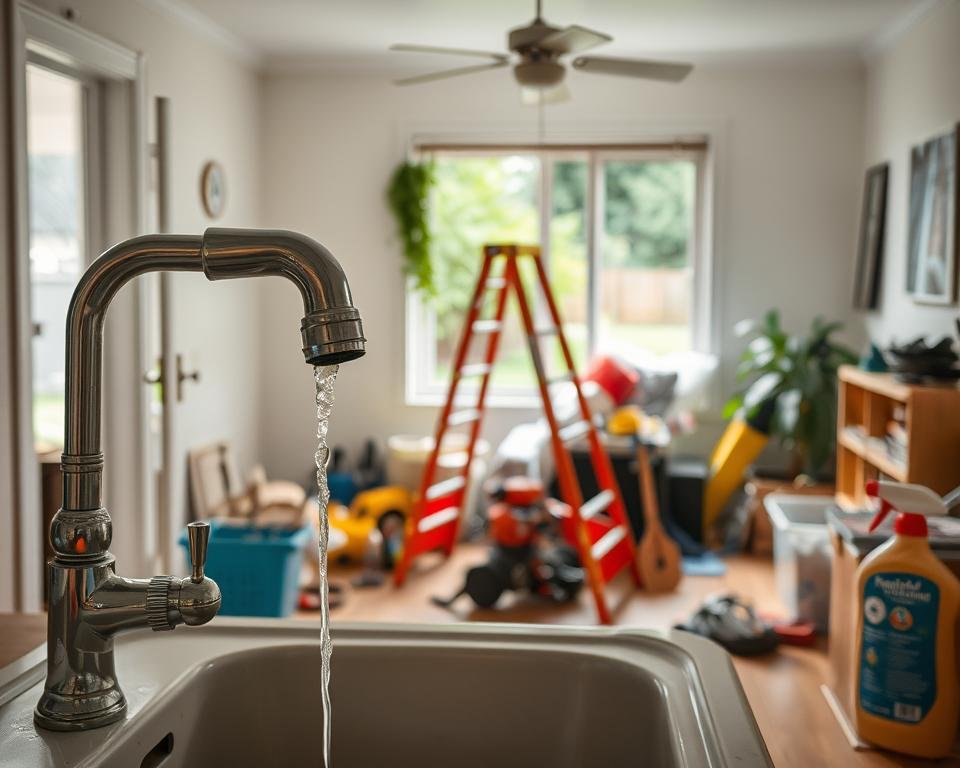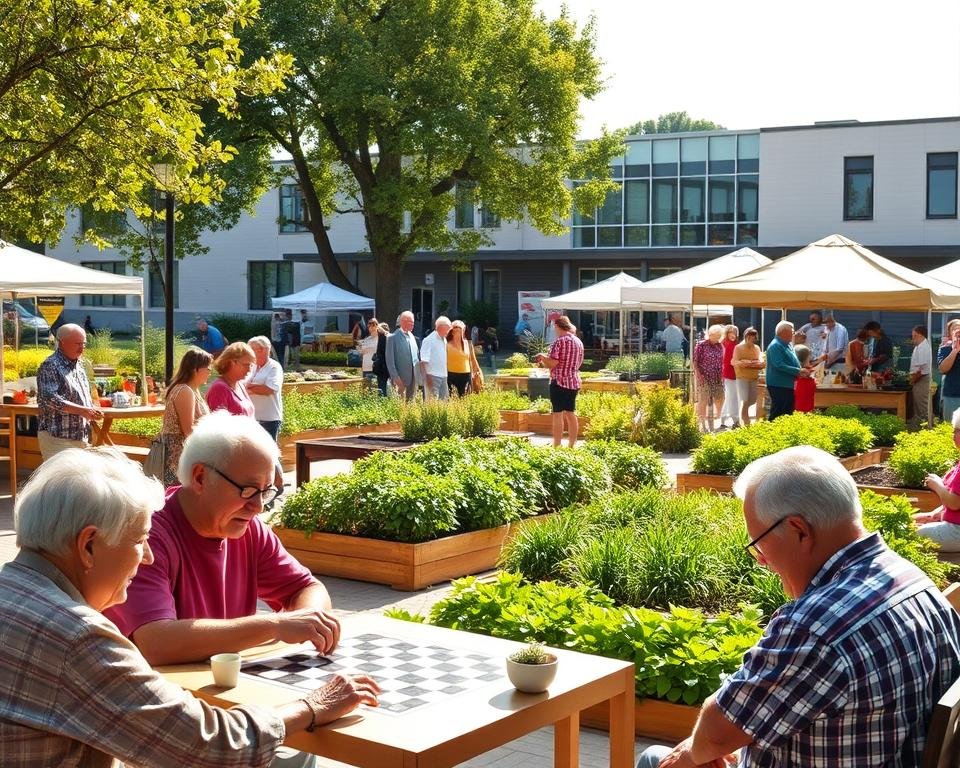Did you know 1 in 3 adults aged 70+ report a better quality of life after moving to a senior-focused community? This surprising shift isn’t just about convenience – it’s about reclaiming time, energy, and joy during your golden years.
Imagine trading home repairs and yardwork for morning yoga classes and book clubs. Modern senior living communities eliminate chores like housekeeping and maintenance, letting you focus on what truly matters. You’ll find built-in security features and neighbors who share your life stage, creating both safety and camaraderie.
Downsizing might feel daunting, but it often leads to simpler routines and fewer responsibilities. Many residents discover new hobbies through art workshops, group trips, or fitness programs tailored to their abilities. The best part? You maintain control over your daily schedule while having support available when needed.
Key Takeaways
- Professional teams handle chores like laundry and home maintenance
- 24/7 security systems and emergency response features
- Regular social events prevent isolation and boost mental health
- Smaller living spaces reduce stress and increase free time
- Flexible meal plans and transportation services
- Cost structures vary – compare amenities and care levels
Understanding Independent Living Options
What if your golden years could mean more freedom, not less? Unlike assisted living or nursing homes, these communities focus on empowering residents through simplified lifestyles rather than medical care.
Defining Independent Living
This option suits those who want maintenance-free spaces with social opportunities. Housekeeping, repairs, and yardwork get handled for you. You keep privacy in your own apartment or cottage while enjoying group activities and shared amenities.
Varieties of Senior Housing and Communities
Choices range from cozy studios to detached homes with private patios. Some prefer apartment-style setups with elevators and community dining rooms. Others opt for villa-style neighborhoods where they can garden or host friends family gatherings.
Active adult communities often include fitness centers and art studios to help you pursue passions. When comparing senior housing types, consider how layouts and services match your daily rhythm. A well-chosen space boosts your quality life by removing chores while keeping connections strong.
Whether you love cooking in a full kitchen or prefer chef-prepared meals, living options adapt to your preferences. The right environment lets you focus on book clubs, day trips, or simply relaxing with neighbors who share your interests.
Assessing Home Maintenance and Safety Challenges
Ever wonder why 60% of seniors say home upkeep becomes their biggest headache after 65? Climbing ladders to clean gutters or wrestling with a stubborn lawnmower isn’t just tiring – it can pose real risks as you age. Those once-manageable tasks now drain energy you’d rather spend enjoying hobbies or time with loved ones.

Overcoming Home Upkeep Struggles
Senior-focused communities tackle these hurdles head-on. Professional teams handle everything from changing lightbulbs to shoveling snow, while weekly housekeeping keeps your space spotless. You’ll never need to hunt for a reliable plumber again – maintenance staff address issues before they become emergencies.
Managing Emergency Repairs and Safety Concerns
Imagine a burst pipe at 2 AM in your current house. Now picture texting a 24/7 repair team instead of scrambling for help. Secure facilities add peace of mind with grab bars, emergency call systems, and well-lit pathways monitored by staff.
Downsizing might feel overwhelming, but trading square footage for freedom pays off. One resident recently shared, “I didn’t realize how much stress came from worrying about my roof until someone else took care of it.” With chores handled, you regain hours each week for pottery classes, morning walks, or simply relaxing with a good book.
Enhancing Social Engagement and Community Connection
What happens when laughter becomes your daily medicine? Research shows seniors with regular social connections experience 30% lower rates of depression compared to isolated peers. Modern communities combat loneliness through vibrant activities designed to spark joy and build meaningful bonds.
Combating Loneliness with Community Activities
Morning coffee clubs evolve into lifelong friendships here. Structured events like painting workshops or trivia nights give everyone easy ways to participate. One resident shares, “I’ve made more friends in six months here than in twenty years at my old neighborhood.”
Benefits of On-Site Social Opportunities
Communities offer everything from yoga classes to wine tastings – no planning required. These social engagement benefits create natural support systems. Neighbors become workout buddies, book club critics, or gardening partners.
Informal gatherings matter too. Shared meals in dining rooms often turn into spontaneous storytelling sessions. Many find the environment mirrors family life, with staff remembering birthdays and anniversaries. When using a moving checklist, prioritize communities offering both scheduled events and cozy common areas for casual chats.
From group museum trips to balcony gardening competitions, options adapt to different personalities. This variety ensures every day brings new ways to connect, learn, and thrive alongside peers who truly understand this life chapter.
Evaluating Transitioning to Independent Living After Retirement
What if your ideal retirement setup isn’t about giving up freedom but gaining it? Start by asking yourself practical questions that reveal what truly matters for your next chapter. This evaluation helps match your priorities with communities designed to enhance your daily experience.

Identifying Your Personal Needs and Preferences
Does maintaining a large house drain your energy? Consider how much space you actually use versus what requires upkeep. Many find smaller homes with accessible layouts reduce stress while keeping essentials within reach. Proximity to family, healthcare, and favorite activities also plays a key role in long-term satisfaction.
Ask yourself:
- How do stairs or yardwork impact my current routine?
- Would having social events down the hall improve my week?
- What safety features would help me feel secure?
Financial and Lifestyle Considerations
Compare your current housing costs with community fees that bundle services like meals and maintenance. One resident noted, “I finally realized I was paying more for repairs than for relaxation.” Look for transparent pricing models that align with your budget and include perks like transportation or fitness classes.
Factor in how support services could reclaim hours each week. Time spent cooking or cleaning might shift to hobbies or trips with new friends. By weighing both practical and personal elements, you create a roadmap for a fulfilling environment tailored to your vision.
Pursuing New Passions and Lifelong Learning
What if your next chapter could spark creativity you never knew you had? Senior communities thrive by offering vibrant spaces where curiosity meets opportunity. With chores handled, you gain time to reignite old interests or discover entirely new ones.
Rediscovering Hobbies and Interests
That paintbrush gathering dust? Communities host art studios with weekly workshops. Always wanted to master digital photography? On-site computer labs offer beginner-friendly classes. One resident recently shared, “I finally wrote my memoir thanks to the writing group here – something I’d postponed for decades.”
Exploring Fitness and Educational Opportunities
Morning tai chi sessions and water aerobics keep joints moving while building healthier habits. Many facilities partner with local colleges for guest lectures on history or science. Language clubs turn learning Spanish into social hour with friends.
Book clubs dissect bestsellers, while gardening groups swap heirloom tomato tips. These activities do more than fill calendars – they strengthen mental sharpness and create bonds with like-minded people. As one instructor notes, “Our students often surprise themselves with what they achieve.”
Whether you’re perfecting pottery or exploring yoga, every class becomes a chance to grow. This blend of movement and mental stimulation forms the foundation for thriving in your golden years.
Embracing a Community-Oriented Lifestyle
Could your retirement years be the most socially vibrant time of your life? Communities designed for active seniors thrive on connection, offering daily opportunities to bond with peers who share your interests and energy. This environment turns casual neighbors into lifelong friends through organic interactions and structured events.

Building Peer Relationships
Shared passions become the glue for meaningful connections here. Book lovers find debate partners in library nooks, while gardening enthusiasts swap tips near raised flower beds. One resident remarked, “I’ve bonded more over morning crossword puzzles here than I did at my old job.”
Participating in Organized Activities
From salsa classes to photography clubs, calendars overflow with resident-led options. Weekly trivia nights spark friendly rivalries, while cooking workshops turn meal prep into group adventures. Many top communities let you propose new activities – start a stargazing group or organize day trips.
This lifestyle removes the effort of planning social outings. Want to try watercolor painting? Walk downstairs to the art studio. Crave live music? Check the community theater schedule. With peers cheering on your interests, every day becomes a chance to grow.
Navigating Living Options, Amenities, and Support Services
How do daily conveniences shape your golden years? Modern communities eliminate hassles through thoughtful services that blend practicality with comfort. Let’s explore features that simplify routines while preserving your autonomy.
Understanding On-Site Services and Dining Options
Chef-prepared meals replace grocery shopping and dishwashing. Flexible dining plans accommodate dietary needs while freeing up hours each week. One resident shares, “I’ve rediscovered my love for bridge since I’m not stuck in the kitchen anymore.”
Maintenance teams handle everything from lawn care to appliance repairs. Weekly housekeeping keeps your space tidy without vacuuming marathons. Scheduled transportation removes the stress of driving to medical appointments or cultural events.
Exploring Pet-Friendly and Accessible Housing
Furry companions often welcome! Communities with pet policies provide dog parks or walking trails. Accessible designs feature zero-step entries and grab bars – ideal for mobility challenges. These features ensure both safety and companionship.
Coordinating with Continuing Care Resources
Many locations partner with health providers for seamless future planning. While cost structures vary, bundled services often prove more affordable than managing home upkeep alone. As one family noted, “Knowing Mom can age in place here gives us peace of mind.”
By evaluating amenities against your priorities, you’ll find a balance between support and independence. The right mix of services lets you focus on joy rather than chores.
Planning for Future Care Needs and Sustained Independence
What security comes from knowing your next chapter adapts as gracefully as you do? Many communities now offer flexible care models that evolve with your needs, letting you focus on enjoyment rather than uncertainty. This forward-thinking approach keeps your lifestyle vibrant while preparing for potential changes.
Building Resilience Through Smart Choices
Continuing Care Retirement Communities (CCRCs) shine here. These setups allow you to stay in familiar surroundings even if health needs shift. One resident shared, “Knowing I won’t have to move again gives me peace to fully enjoy today.” With tiered care options, you maintain quality relationships and routines while accessing additional support seamlessly.
On-site dining services play a surprising role in long-term ease. Nutritious meal plans reduce daily chores while supporting health goals. Communities with full-service restaurants eliminate grocery runs – perfect for days when you’d rather join a gardening club than cook.
A robust calendar of events does more than entertain. Regular social activities and fitness classes help preserve mobility and mental sharpness. Many find that built-in amenities like transportation services and housekeeping create more energy for hobbies and friendships.
When comparing options, look for:
- Clear pathways to assisted living or memory care
- Flexible contracts that prioritize your autonomy
- Staff trained in multiple care levels
By choosing communities with these features, you craft an environment where every tomorrow feels as promising as today. Thoughtful planning now means you’ll always have the right support to thrive on your terms.
Conclusion
Ready to trade household chores for morning coffee with friends? This article has shown how maintenance-free housing options create space for what truly matters. Communities handle repairs while offering plenty of social events – book clubs, fitness classes, and shared meals become your new routine.
Safety features and neighborly bonds replace isolation. You keep autonomy over daily choices while having assistance available when needed. It’s about designing a lifestyle where gardening tools collect memories, not dust.
Use this guide to explore housing setups matching your priorities. Thoughtful planning ensures smooth changes – compare amenities, visit communities, and ask about meal plans. With plenty of resources available, your next chapter could be the most vibrant yet.
Need personalized advice? Reach out to local senior services. Your golden years deserve a setting where joy matters more than mowing lawns. Start crafting that reality today.
